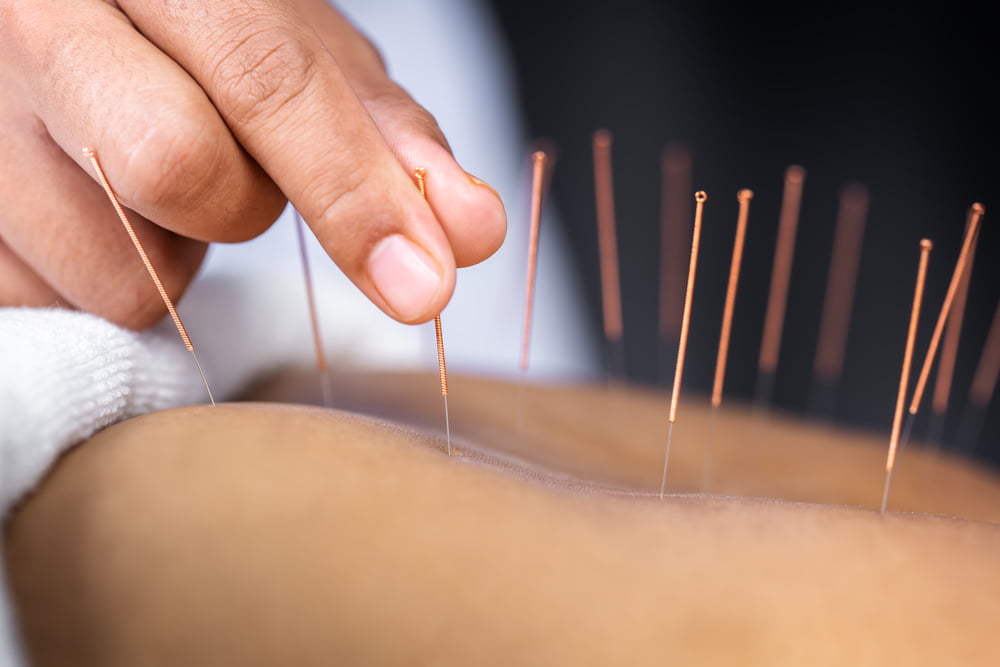Acupuncture is an excellent adjunct to Physiotherapy. It’s like another tool in our toolbox.” says Tori, Physiotherapist. It is the practice of treating conditions by stimulating certain areas of the skin with needles, which is highly effective in treating pain, among other things.
What Is Acupuncture?
Acupuncture is an evidence-based medicine which has been around for over 2500 years and is proven by thousands of studies.
It is also a minimally invasive way to stimulate nerve-rich areas of the skin surface to influence tissues like ligaments, muscles, joints, nerves, and glands. This triggers various functions of the body such as the immune system, circulatory system, wound healing, and pain modulation.
Each acupuncture needle produces a minute injury at the insertion site. Although it’s barely enough to cause little to no discomfort, it’s enough to signal the body to respond to the imminent threat. This response then involves stimulation of the central nervous system. This releases chemicals into the muscles, spinal cord, and brain. These biochemical changes may stimulate the body’s natural healing abilities.
Release of dopamine after an acute painful stimulus (for example, the insertion of an acupuncture needle or a typical injury) acts as an instinctual signal, initiating the motivation to avoid pain depending on the situation at hand. In addition, pain relief is normally interpreted as a positive response to the stimulus and initiates the release of dopamine.
In terms of results, it’s nearly impossible to say what one should expect, as everyone responds to and experiences acupuncture differently. However, we can say it is rare to not have a positive experience when using acupuncture.
“There is no universal response to acupuncture,” Tori Sloane, Physiotherapist explains. “Some people experience an improvement after the first treatment, and for others, it can take several treatments before noticing a positive change. On average patients notice relief in 1-3 sessions.”
Along with pain & inflammation reduction most also feel quite relaxed afterwards or sometimes fatigued. This is due to the body performing a task and needing to deplete energy to do so. An increased amount of acupuncture needles used in an area will increase this effect.
Acupuncture can be incorporated into your Physiotherapy session if your Clinician deems this appropriate.
How Acupuncture Can Help
The actual treatment portion of acupuncture may last around 20 minutes and is generally done at the end of your Physiotherapy treatment. At Fit4Life Professional Physiotherapy in Winnipeg, there is no additional charge for acupuncture in your treatment sessions.
Summarization of effects of acupuncture complementing Physiotherapy:
- Increased Pain Relief: Acupuncture stimulates the release of endorphins, the body’s natural painkillers, providing an additional layer of pain relief to complement the techniques already used in Physiotherapy.
- Improved Circulation: Acupuncture promotes blood flow to the injured or affected areas, supplying them with vital nutrients and oxygen, which assists in the healing process.
- Stress Reduction: Physiotherapy sessions can cause discomfort. Acupuncture treatment can help reduce stress and anxiety by activating the body’s relaxation response. This allows for a more effective rehabilitation experience.
- Muscle Relaxation: Acupuncture can help relieve muscle tension and promote relaxation, complementing the hands-on techniques used in Physiotherapy to further improve range of motion, muscle flexibility, and tension.
- Faster Recovery: When acupuncture is integrated with Physiotherapy, it can accelerate the healing process, potentially reducing the overall duration of your recovery. This is due to helping the body get rid of swelling and also reducing pain which allows you to be more thorough with your exercise program and potentially lets your Physiotherapist augment your personalized exercise program challenge level at an increased rate.

